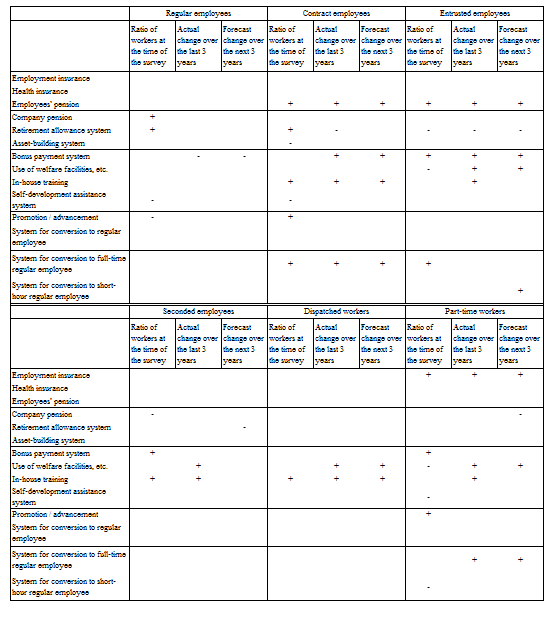JILPT Research Report No.161
Transition in Diversification of Employment III:
2003 / 2007 / 2010/ Based on Special Tabulation of the “Survey on Diversification of Employment” of the Ministry of Health, Labor and Welfare —
November 5, 2013
Summary
Research Objective
The aim of this Research is to ascertain trends in non-regular employment in the period from 2003 to 2010, based on special tabulation of the Ministry of Health, Labour and Welfare "General Survey on Diversified Types of Employment" (or "Diversification Survey", this time focusing on the three surveys in 2003, 2007 and 2010). The Diversification Survey is one source of general government statistics on the progressive trend toward non-regular employment, a major characteristic of labor and employment in recent years. Besides this, other objectives are to conduct requisite analysis based on time-specific problem awareness and to draw out political implications. JILPT has produced special tabulations of these surveys continuously, this being the fourth such tabulation.
Research Method
Special tabulation of the Ministry of Health, Labour and Welfare "General Survey on Diversified Types of Employment"
Major Findings
(Transition in diversification of employment in 2003-2010)
- In the trend toward non-regular employment between 2003 and 2010, a significant increase was seen between 2003 (non-regular ratio: 34.6%) and 2007 (37.8%), but the increase slowed from then until 2010 (38.7%). While a rise in the non-regular ratio of full-time workers (contract employees and "entrusted" or temporary contract employees) continued to be seen in that time, the ratio of dispatched workers doubled between 2003 and 2007 but then fell sharply by 2010. Trends in dispatch from agencies were particularly pronounced in manufacturing industries; the increase in the first period is thought to reflect the lifting of the ban on dispatch work in manufacturing work, and the decrease in the second half to reflect a squeeze following the Lehman shock, respectively.
- On the reasons why businesses utilize non-regular employment, for contract employees many businesses cite "To deal with specialized operations" and "To obtain capable personnel who will contribute immediately", for dispatched workers "To obtain capable personnel who will contribute immediately" and "To adjust employment volume in response to business cycles", and for part-time workers (hereinafter "part-timers") "To economize on wages (and other labor costs)" and "To deal with busy and slack periods on a daily or weekly basis". Although the ranking of these reasons has not changed significantly, in 2007 the most common reason for dispatched workers was "Regular employees cannot be obtained", while the most common reason for part-timers was "To deal with extended business (operation) hours". This suggests that, in a period of economic expansion, reasons based on specific employment formats tend to come closer to the fore, along with reasons related to labor costs and employment adjustment.
- On the age composition for each format of non-regular employment, the proportion of contract employees and entrusted employees aged 60 and over has risen. This is thought to reflect the increased response to employment of older workers by businesses. Among dispatched workers, while the proportion of those in their 20s is in a declining trend, the ratios of those in their 30s and 40s appear to be in a rising trend. This reveals an increase in the age of people employed in dispatched work.
- As reasons why non-regular employees choose their current format, a large proportion of full-time non-regular workers state "Because there were no companies where it was possible to work as regular employees". "To utilize specialized qualifications and technical skills" is also a commonly stated reason, while a large proportion of female workers state "To help with family income". On the other hand, a large proportion of part-timers state "Because I want to work at hours that fit my own circumstances" as their reason.
- As to levels of satisfaction with vocational life in general, an overall tendency to decline between 2003 and 2007 but to remain flat or increase until 2010 is seen. Meanwhile, the satisfaction levels of regular employees have tended to rise throughout the period in question (see Figure 1).
Figure 1. Trends in satisfaction with vocational life in general (D.I.)
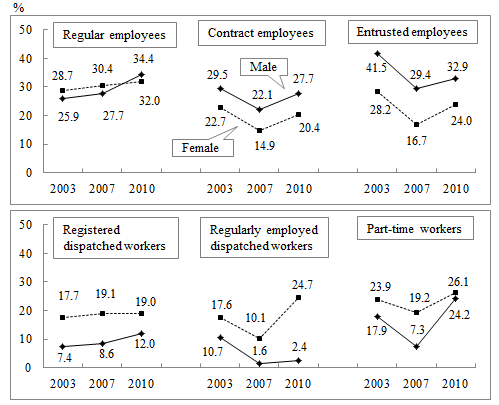
Note: "Satisfaction D.I." is calculated by subtracting the proportions of those who replied "Dissatisfied" and "Somewhat dissatisfied" from the proportions of those who replied "Satisfied" and "Somewhat satisfied" (%).
(Analysis by theme / Trends in entrusted employees in their early 60s following the introduction of measures for continued employment)
- Compared to the change between 2003 and 2007, the degree of shift from regular employees aged 55-59 to entrusted employees aged 60-64 seems to have grown larger in the change between 2007 and 2010, and the same trend is seen in the shift to contract employees. On the other hand, the degree of shift to part-timers has decreased. Meanwhile, entrusted employees aged 60-64 have relatively high levels of satisfaction compared to other formats. The continued employment of those aged 60-64 following the introduction of measures to secure employment under the Act on Stabilization of Employment of Elderly Persons therefore appear to have been more or less successful. Conversely, in the year-on-year change in entrusted employees aged 60-64, satisfaction appears to have slightly fallen. This would seem largely due to the fact that, although adjustments were made in terms of wages when continuing employment, the systems previously implemented for other working conditions and working environments were more or less followed and no great change was made. In future, an appropriate response in terms of working conditions and environments (such as job content and working hours) would appear to be necessary. On adjustments in terms of wages, moreover, it should also be necessary to ensure a certain level of wages (see Figure 2).
Figure 2. Wage amounts for male entrusted employees aged 60-64 and "wage" satisfaction score (2010 survey)
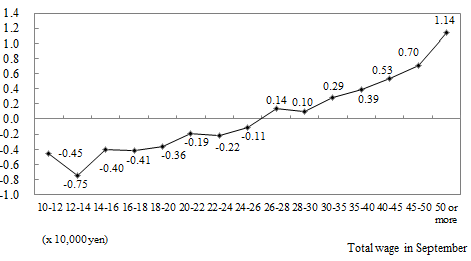
Note: The "Satisfaction score" is the average score obtained by totaling "Satisfied" = 2 points, "Somewhat satisfied" = 1 point, "Neither" = 0 points, "Somewhat dissatisfied" = 1 point, and "Dissatisfied" = 2 points, excluding cases of no response.
Based on 2010 data. When the survey year is not specified below, the figures are based on 2010 data.
(Analysis by theme / Trends in part-timers following the amendment to the Part-Time Labor Act)
- Following the enforcement of the amended "Part-Time Labor Act", significant progress has been seen in the use of welfare facilities and others for part-timers and the application of systems, particularly in terms of vocational development; the system of promotion to regular employee status is also progressively spreading. A degree of improvement has also been seen in equal or balanced treatment. On the other hand, there are also signs of a trend toward a "segregation of duties" between regular employees and part-timers, and in businesses that employ part-timers "To enable regular employees to specialize in key operations", the wage gap compared to regular employees was calculated to have increased somewhat from 74.0 in 2003 to 73.5 in 2010. Meanwhile, with the progressive deployment of contract employees as full-time non-regular employment, a trend is also seen for contract employees to be perceived as "normal workers" in contrast to part-timers (see Figure 3).
Figure 3. Average wages of part-time workers (converted to hourly wage) compared to regular employees and contract employees (females, aged 20-59)
(1) Businesses with regular employees and part-timers but no contract employees (regular employees = 100)
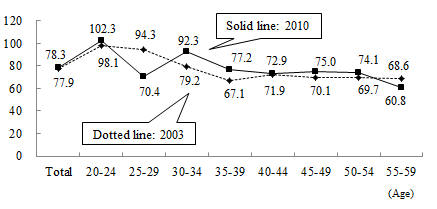
(2) Businesses with regular employees, contract employees and part-timers (regular employees = 100)
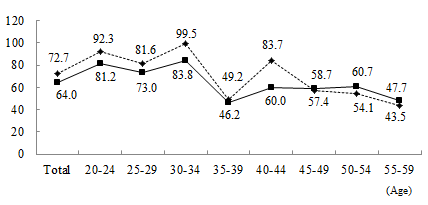
(3) Businesses with regular employees, contract employees and part-timers (contract employees = 100)
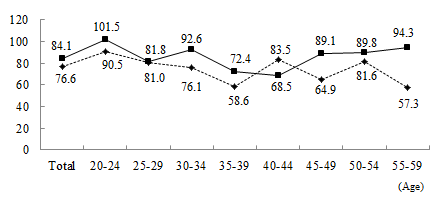
(Analysis by theme / Trends in employment of dispatched workers for manufacturing work following the lifting of the ban and the Lehman shock)
- The lifting of the ban on employment of dispatched workers for manufacturing work resulted in a quantitative expansion of employment opportunities for male senior high school graduates, particularly in younger age groups, thanks to a coincidental export-led economic recovery at the time. In terms of wages, too, when employed in "product manufacturing work" in non-regular employment formats, their wages were higher than those of part-timers and temporary employees (= short-term employment known as "arubaito"). However, many workers chose the dispatched work format involuntarily because of the lack of employment opportunities for regular employees. Not only were they in a relatively inferior position in comparison to regular employees, but their wages were also lower compared to contract employees, and their working hours were relatively longer as well. These and other reasons have made it difficult to obtain a sense of acceptance or satisfaction with qualitative working conditions and environments (see Figure 4). Moreover, jobs provided in "product manufacturing work" are sometimes simple and carry little responsibility, and this was thought to make it harder for these workers to obtain prospects for career formation. Nevertheless, although employment of dispatched workers for manufacturing work shrank considerably after the Lehman shock, the satisfaction levels had recovered in 2010, and a degree of leveling may be seen in this type of employment.
Figure 4. Trends in satisfaction scores of workers in "product manufacturing work" (males)
— Working life in general —
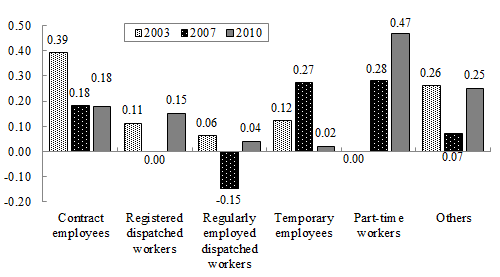
(Analysis by theme / Analysis of wage gap between regular employees and part-timers)
- On analyzing the wages of part-timers by estimating a wage function, the following results were produced. The wage gap between regular employees and part-timers is shown to be due not only to the difference in length of hours worked between the two, but also largely due to a disparity in the rate of wage increase with age, the difference in length of service, and differences in the rate of application of various systems such as promotion and advancement (see Figure 5). Of differences between individual attributes, difference in length of service is a particularly significant factor. It has also been posited that the probability of female part-timers wanting to work for other companies increases as their dissatisfaction with the substance of work and rewarding work, companies´ systems of training and ability development, human relations with regular employees and other factors increase. Thus, to extend the length of service by female part-timers, efforts to eliminate this kind of dissatisfaction could be seen as important.
Figure 5. Causes of wage disparity between regular employees and part-time workers seen in terms of a wage function (females)
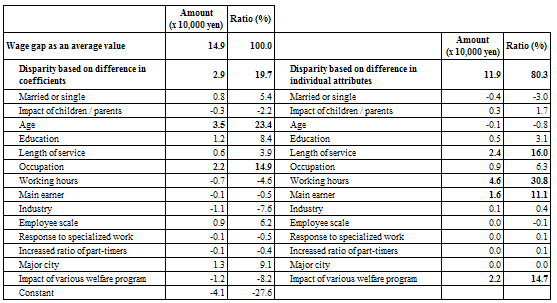
Note: "Disparity based on difference in coefficients" means the disparity based on differences in wage systems and evaluation between regular employees and part-timers in a business. "Disparity based on difference in individual attributes" means the disparity based on differences between average attributes of regular employees and part-timers (age difference, different length of service, etc.).
(Analysis by theme / Employment realities and awareness of fixed-term contract workers based on differences in reasons for utilization by businesses)
- On analyzing how reasons for utilizing fixed-term contract workers by businesses affect workers´ employment realities and satisfaction levels, the following results were obtained. When the reason for utilizing such workers is "To deal with specialized operations", stability of employment, wages and levels of settled employment are high, and there are generally high levels of satisfaction. When the reason is "To obtain capable personnel who will contribute immediately", stability of employment and wages are high but settled employment is low, while the level of satisfaction with "Substance of work and rewarding work" is high. These reasons could generally be said to work in a positive direction. By contrast, when the reason is "To economize on wages", settled employment is high but wages are low, and satisfaction levels are low in many categories. Again, when the reason is "To respond to shifts in special or seasonal work volume", stability of employment, wages, and settled employment are all low, and satisfaction with "Welfare benefits" and "Education and training/capacity development" is also low. These reasons could generally be said to work in a negative direction (see Figure 6).
Figure 6. Aggregated results of regression analysis on the impact of reasons for utilizing fixed-term contract workers on their employment realities and satisfaction levels
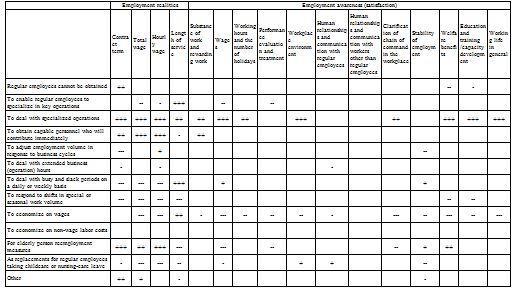
Note: +++ indicates a positive 0.1% level of significance, ++ a positive 1% level of significance, + a positive 5% level of significance, --- a negative 0.1% level of significance, -- a negative 1% level of significance, and - a negative 5% level of significance.
(Analysis by theme / Realities and factors of non-regular employees wishing to increase working hours – "Hidden unemployment")
- On examining "incomplete employment" as one form of involuntary action related to non-regular employees and analyzing the realities and factors of short-hour workers who seek additional employment, the following results were obtained. Married women tend not to seek an increase in their current working hours, but those with children have a higher tendency to seek an increase in working hours within a range not exceeding 35 hours a week. Also, in the case of women aged 40 and over, there is a tendency for the main earner (principal livelihood earner) to seek an increase in working hours. It appears highly likely that unmarried women aged 40 and over, though seeking full-time employment, involuntarily engage in short-hour work (involuntary part-time employment) (see Figure 7). Besides this, those engaged in incomplete employment were shown to have generally low levels of satisfaction.
Figure 7. Important results of analysis on the tendency to enter incomplete employment (females) (only main factors shown)
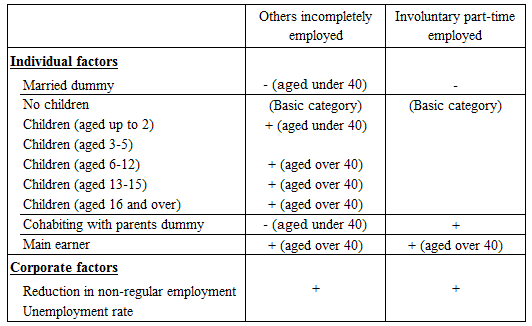
Note: 1. "+" and "-" indicate positive and negative impacts, respectively. "Under 40" and "over 40" indicate that there is a significant impact in the under-40s and over-40s, respectively.
2. "Incompletely employed" refers to workers working less than 35 hours a week who wish to increase their present working hours, Involuntary part-time employed" those who seek weekly working hours 35 hours or more, and "Other incompletely employed" those who seek weekly working hours within the range of less than 35 hours.
(Analysis by theme / Impact of application of social insurance and other systems on non-regular employment)
- On analyzing differences in the ratios of various non-regular formats in businesses depending on whether social insurance and other systems are applied, a variety of results were obtained. According to analysis using the 2010 survey, for example, businesses applying employment insurance systems to part-time workers have a high ratio of part-time workers, and are expected to increase this ratio in future. Meanwhile, the ratios of contracted and entrusted employees are higher in businesses applying employees´ pensions to these employees, and these ratios are also expected to rise in future. As these findings suggest, the result is that non-regular employees working full-time or with working hours equivalent to this are not reduced in volume due to the increased labor cost caused by the application of social insurance, but are utilized with appropriate burdens of social insurance. Moreover, the increase in labor costs due to applying social insurance appears not necessarily to reduce the future ratios of non-regular employees. Again, businesses that apply systems of in-house training to non-regular employees currently have relatively high ratios of these, and are expected to increase these ratios in future. Conversely, businesses that apply systems of assistance for self-development activity currently have high ratios of regular employees and low ratios of non-regular employees. It would therefore appear, among others, that businesses aiming to raise their ratio of non-regular employees, though applying education and training systems, tend not to go as far as applying systems to assist self-development (see Figure 8).
Figure 8. Results of analysis on the impact of applied employment-related systems on ratios of workers in each format, and change in the same (past to present) (2010 survey)
Note: Plus and minus signs indicate statistically significant results, "+" indicating an increase effect and "-" a decrease.
Policy Implications
- One of the focal points of this Research was to reconfirm the trends in non-regular employment in the period in question through special tabulation of fully representative government statistical data. At a stage when non-regular employment has become generalized or even universal, as in recent years, it could be said that the era of simple "cost cutting", whereby employees in the non-regular format are only utilized quantitatively, would seem to have passed. Instead, we could be said to have entered an era in which, irrespective of whether regular or non-regular formats, more importance is placed on how their abilities are raised and drawn out, how these are linked to corporate performance, and how this is reflected in employees´ treatment.
- Policy tasks in individual employment formats may be pointed out in response to topics in recent years. These include the fact that continued employment of older workers in the short term has, in many cases, been manifest in the format of “entrusted employees”, but also that wage adjustment as well as improvements to working hours and other employment conditions and environments will likely be an issue in future; the fact that, when promoting equal or balanced treatment (terms) for part-time workers, moves to segregate their work from regular employees and moves to respond through analogy with contract employees and other full-time non-regular formats have been suggested, and the organization of the requisite rationale needs to be studied; and the fact that, with regard to dispatch work, improving the employment environment in dispatch for manufacturing work is an issue, while the connection with non-regular formats in the broad sense, including so-called contractor labor, also needs to be considered.
- When promoting policies on non-regular employment, it will be important to enumerate tasks by dividing this employment format into segments based on the requisite perspectives. Until now, the dividing axis whether part-time or full-time work and the dividing axis of so-called involuntary employment have been shown. Along with that, however, the importance of divisions based on reasons for utilization by businesses has also been reconfirmed, as well as divisions based on the employee’s family composition and whether the employee is the principal livelihood earner.
- As to the impact of the application of social insurance and various other systems on non-regular employment, it was confirmed that this is not a simple matter such as can be envisaged through cost theories alone. A precise grasp of the actual situation is required, including the response awareness by the parties concerned.
- Although this may not necessarily be a direct conclusion drawn from the Research this time, it may be pointed out, among others, that the diversification of ways of working needs to be kept in mind when studying labor policies, and that it is important that employment rules should be decided in companies through communication between labor and management, for both regular and non-regular workers.
Policy Contribution
The purpose of this Research has been to ascertain trends in non-regular employment in the period in question through special tabulation of fully representative government statistical data, and to provide basic data contributing to the study of related policies, as well as presenting policy tasks through analysis. It is hoped that the results will be utilized in line with this purpose and gist.
Contents
- Cover – Preface – Authors – Contents
- Introduction Gist of the Research and summary of results
- Part I Transition in diversification of employment –– Trends in data from the 2003, 2007 and 2010 Ministry of Health, Labour and Welfare “Diversification Survey”
- Chapter 1 Realities of utilization of non-regular employees in businesses and changes therein –– From the survey of businesses
- Chapter 2 Attributes of non-regular employees, their reasons for choosing employment formats and levels of satisfaction –– From the survey of individuals
- Part II Analysis by theme concerning diverse forms of employment
- Chapter 3 Kinds of data used to show the topics in this period –– Older “entrusted employees” after measures to secure employment, “part-timers” after the amendment to the Part-Time Labor Act, and “Dispatched workers” after the lifting of the ban on dispatch for manufacturing work and the Lehman shock ––
- Chapter 4 The wage gap between regular employees and part-time workers
- Chapter 5 Reasons for utilizing fixed-term contract workers, their employment realities and employment awareness
- Chapter 6 The gap between actual and preferred working hours — Reality and factors of "hidden unemployment" —
- Chapter 7 The impact of the application of social insurance and other systems on worker ratios, by employment format
- Appendix 1 Estimates of wage functions obtained by controlling fixed effects for businesses
- Appendix 2 Tabulation related to the wishes of fixed-term contract workers to continue employment in future, in terms of length of service
- Conclusion Policy task implications seen in the analysis results (PDF: 46 2KB)
- Reference Data Ministry of Health, Labour and Welfare "Diversification Survey" questionnaire forms
Research Categories
Project Research “Survey Research on directions for strategic labor and employment policies, such as measures for non-regular workers”
Subtheme “Survey Research on diverse ways of working in both regular and non-regular employment”
Research Period
FY2012-2013
Authors (in order of initial contribution)
- Yutaka ASAO
- Research Director, Research Institute for Labour Policy, The Japan Institute for Labour Policy and Training
- Takashi FUJIMOTO
- Assistant Fellow, The Japan Institute for Labour Policy and Training
- Haruhiko HORI
- Vice Senior Researcher, The Japan Institute for Labour Policy and Training
- Koji TAKAHASHI
- Researcher, The Japan Institute for Labour Policy and Training
- Seiga Lee
- Assistant Fellow, The Japan Institute for Labour Policy and Training
- Satoshi NAKANO
- Researcher, The Japan Institute for Labour Policy and Training

